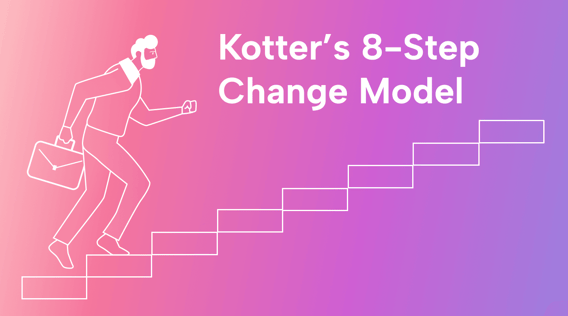Inexperienced managers often underestimate how hard it is to change existing business processes. In the name of efficiency, they might decide to switch to some other software. This usually leads to a long, drawn-out process across teams, miscommunication, data silos (while both tools are used), and missed deadlines.
If you’ve tried to make a similar change in your company, you know it’s a lot harder in practice than in theory. (Especially when in 2022, just 43% of surveyed employees were willing to support enterprise change efforts.)
So what’s the answer?
Kotter’s 8-step change model can help you change your company from the ground up and make the change stick.
In this article, we cover every step of Kottler’s method and share concrete actions you can take at each step to improve your chances. We also explain the pros and cons of the method and whether it's relevant for you.
What is Kotter's change model?
“The 8 Steps for Leading Change” or Kotter’s Change Model is a strategic approach to the change management process. It outlines eight separate steps that companies should take if they want to realize change and make it stick:
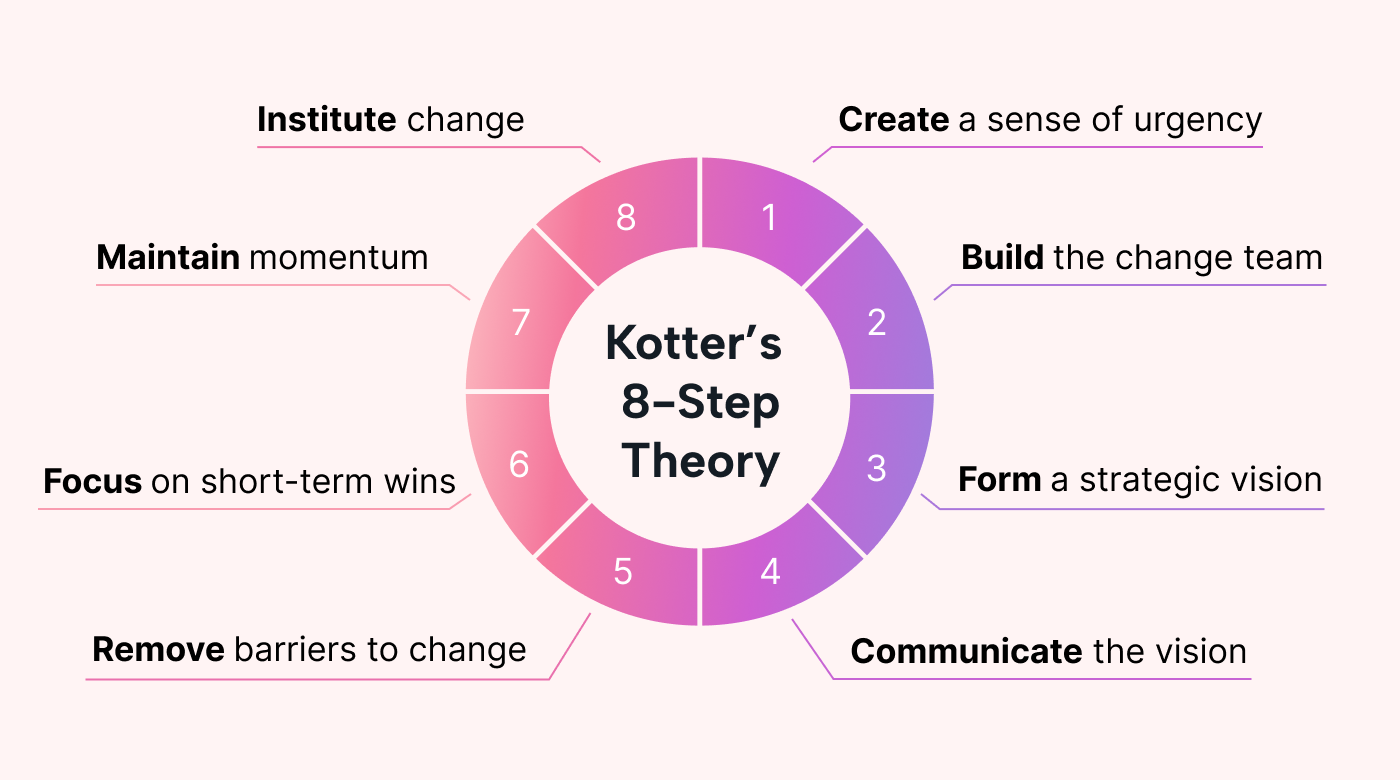 |
- Create urgency
- Build the change team
- Form a strategic vision
- Communicate the vision
- Remove barriers to change
- Focus on short-term wins
- Maintain momentum
- Institute change
We’ll cover these steps in more detail below.
The origin of Kotter’s change model
Dr. John P. Kotter, professor of leadership at the Harvard Business School, gradually invented this framework through experience over four decades.
By observing over 100 companies trying to implement meaningful change and often failing, he discovered common areas where they went wrong.
In his first article on the subject, he listed eight common errors companies make during change initiatives. But over time, Dr. Kotter adjusted them into the concrete steps in the method today.
Since then, John Kotter's change model has become a trusted and widespread change management model, is commonly taught in change management courses, and is used by companies like Pepsico.
But what makes it so popular? To understand that, we need to explore the specifics of Kotter's 8-step change model (and its pros and cons).
The 8 steps of Kotter’s change model explained
Below, we systematically cover each step in Kotter's 8-step model and explain its core objectives. We also highlight specific actions you can take to show you how it might work in your company.
Step 1: Create a sense of urgency
The goal here is to engage your employees in the process. You need to make them care.
And this is an uphill battle — we’ve already seen how over half of modern employees are tired of constant changes.
Here are a few ideas on how to get your employees involved:
- Identify potential threats and communicate how they can impact your future. For example, highlight how a big client is unhappy with results, and if they leave, you might have to reduce staff or can a specific project.
- Highlight opportunities that could help your team thrive. For example, generative AI could give your marketing team time to focus on high-level strategy, not headline generation.
- Bottom line: communicate clearly why your employees should care.
Step 2: Build the change team
When people are on board with the idea, you need to decide who’ll lead the direction of the change initiative.
Try to:
- Involve key stakeholders in the process from day one. They are the people the change impacts most, like users of the software you're introducing or the managers responsible for that department.
- Avoid a team of only managers, partners, and the owner. Every company has informal leaders or "linchpins" who influence the others on their team despite having no official leadership position. To find them, look around for people who suggest or try new ways of doing things.
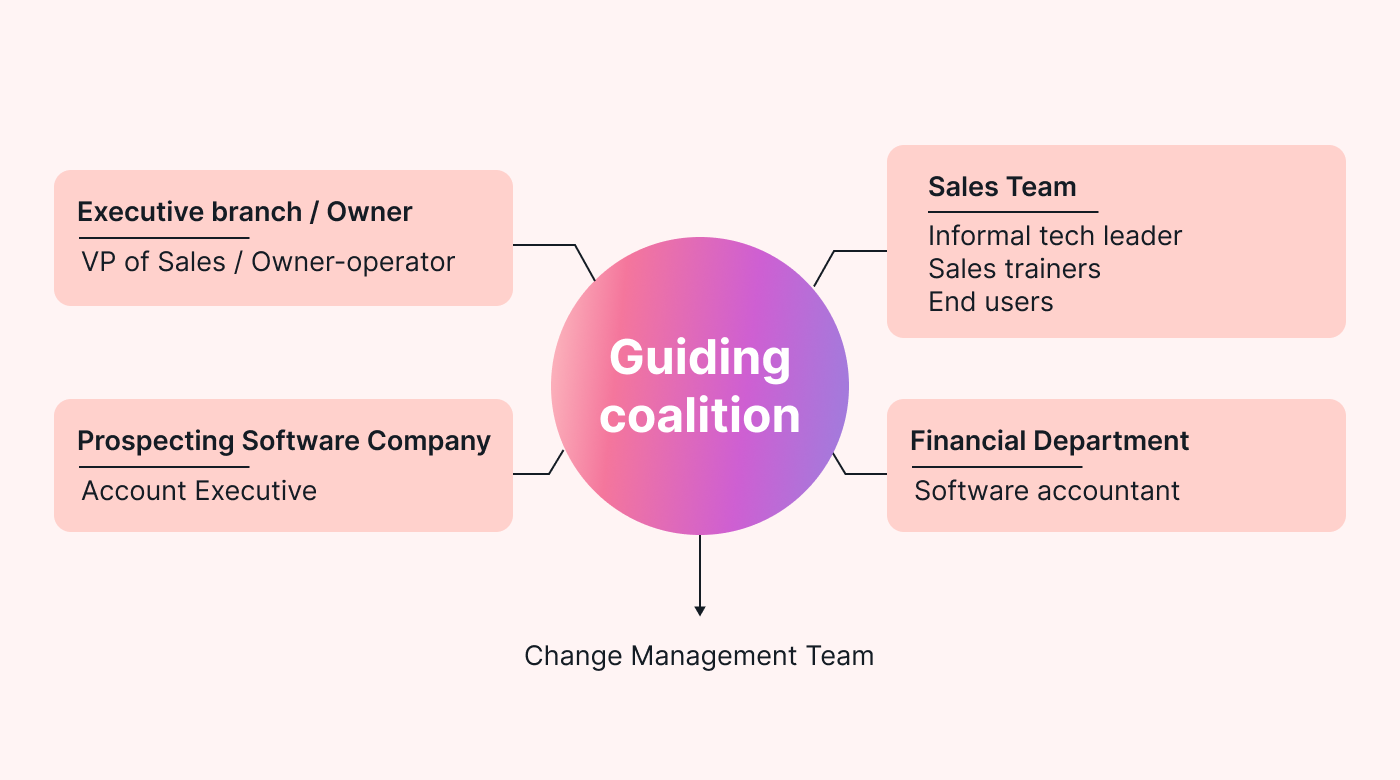 |
This is what a guiding coalition team might look like for a company aiming to improve its prospecting process involving new software:
Step 3: Form a strategic vision
With the coalition formed, you need to form an appealing vision that’ll guide your team and motivate your employees to take action.
- Determine the core values that guide the change process. That might be delivering a superior customer experience if you respond to a drop in client feedback.
- Use the values to guide you to create a vision, and condense it into something short everyone can understand and agree with (max two sentences).
- Explain what your team or organization will look like after the change.
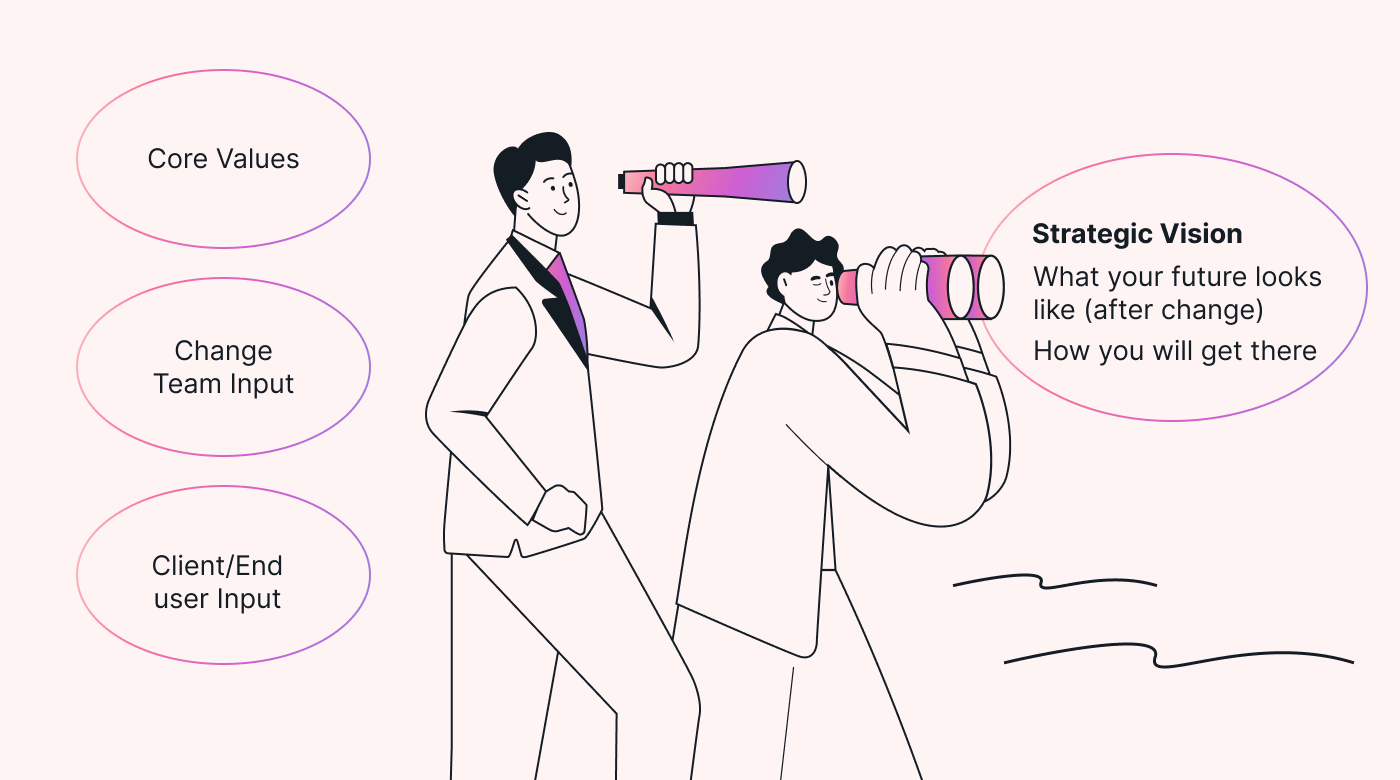 |
Step 4: Communicate the vision
Clear communication is the key to engaging your project team and employees. They need to know and understand your vision.
- Don’t just create a bulletin or a video — hold meetings and workshops and address concerns.
- Discuss the change project and remind everyone of the underlying reasons you uncovered in step one.
Step 5: Remove barriers to change
Inertia is one of the biggest obstacles to change in companies. In a 2022 survey, 40% of companies cited “general organizational resistance to change” as a top reason their Agile transitions weren’t going well.
So, you need to lay the foundation to make the change as smooth as possible.
- Give all employees the necessary training to use new tools and processes.
- Continuously check for barriers or people resisting change — people still using legacy systems.
- Give informal leaders the responsibility for leading change in their teams (and reward them for the added responsibility).
Step 6: Focus on short-term victories
Stoke the fire of motivation by celebrating minor milestones, not just major goals.
- Specify short-term wins — finishing software tutorials and setting up a contingency plan to stimulate a sense of progress.
- Break the long-term vision into concrete goals regarding performance — like increasing prospecting output by 10%, not immediate improvements in the sales pipeline.
- Celebrate the wins to energize your volunteer leaders — the linchpins of the change initiative.
Step 7: Maintain momentum
The goal is to consolidate your progress and keep the initiative going. To do this, you must prevent employees from returning to their status quo.
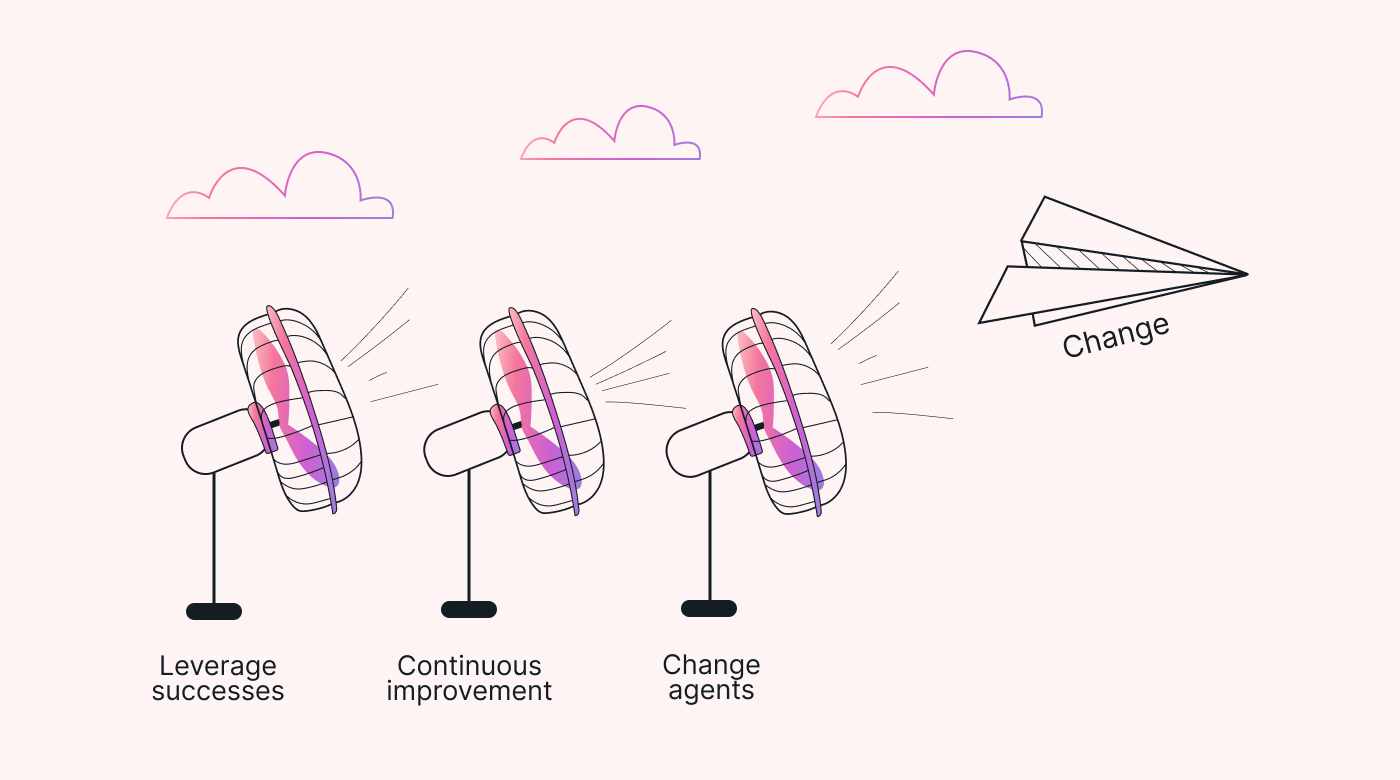 |
- If one team switches to the new process, don’t get stuck celebrating your success. Recruit them to train other teams to keep the momentum going.
- Continue to set goals based on the current situation.
- Strive for continual improvement — the Kanban approach is an excellent way to recruit your entire team to work towards this.
Step 8: Institute change
The change needs to be embedded into your company culture to make the change permanent.
To achieve this:
- Celebrate all improvements and tie them back to threats/opportunities. Continually paint a picture.
- Honestly evaluate the effect of the new processes and check for a cohesive change in company culture — are all managers and employees consistently using the new processes? Adapt a more bottom-up approach if you notice many employees aren’t on board.
- Make sure all company leaders communicate their support towards the change and actively participate in it.
Pros and cons of Kotter’s 8-step change model
The Kotter model is comprehensive, but it's not for everyone. Unless you're trying to make a large-scale change to an enterprise, walking through the entire process might be overkill.
Let’s do a quick run-down of some of the main pros and cons of the approach.
Pros
- It’s a comprehensive framework.
- It involves high-level stakeholders as well as informal leaders.
Cons
- The number and order of steps can be confusing.
- It often leads to upper management holding the reins, with minimal input and engagement from workers and lower-level management.
While Kotter's model encourages otherwise, it can often lead to top-down change management. In a 2022 survey by Gartner, 75% of companies said they took a top-down approach to change.
It may seem obvious that the owner or manager should be the driver of change in the company. Your company, your vision, right?
The problem is that this is a poor recipe for making organizational change stick.
Gartner research shows that a more open source, employee-centric approach can improve chances of success 14x.
That means:
- Involve employees in decision-making from day one.
- Let your employees handle the implementation planning.
- Encourage consistent two-way communication.
 |
In smaller organizations, you can take advantage of the relative ease with which you can assemble teams and directly source your change strategy from them.
How to leverage Kotter’s change model for smaller businesses
The key to making Kotter’s change model work for a smaller organization is to simplify it and scale it down.
Combine steps 1–4 into a single process
Instead of thinking of them as four separate steps, combine finding the change team, urgency, and vision setting into one process.
- Meet and ask employees what they feel isn’t going well, as well as potential opportunities for improvement. Listen to their concerns.
- Ask them to prioritize what challenges to tackle.
- Develop the vision together. You can’t tell them what they want the future to look like.
- During these meetings, employees who care will show themselves. Recruit them to your change team.
Tackle one team at a time
Trying organizational-wide change can often lead to extended bouts of lower productivity, which smaller businesses often can’t afford.
Plus, you may be unable to hire outside “change agents” to manage the process.
For many organizations, the way around these issues is to scale down their change goals and tackle one team at a time.
Schedule time for the change initiative
You can’t change your company in a meaningful way without making time for it. And we mean company time. Don’t give your employees unpaid homework — most simply won’t do it, and you’ll lose goodwill and engagement.
Make sure to fit workshops, meetings, and relevant training into your employees’ schedules.
Find time for change projects with Motion
Dreaming of changing your company is the easy part. Making it stick is hard. Even if you get people involved, how will you engage employees weighed down with their day-to-day tasks?
Motion can help. By improving the time management practices of your entire team, you can help them take the necessary steps to help your organization change. Sign up for Motion’s free trial today.
If you ask us, optimizing your company’s time management sounds like a great way to start your foray into organizational change.

